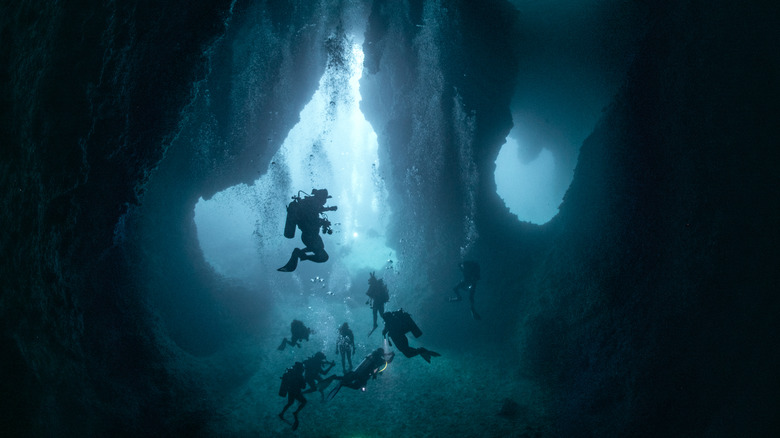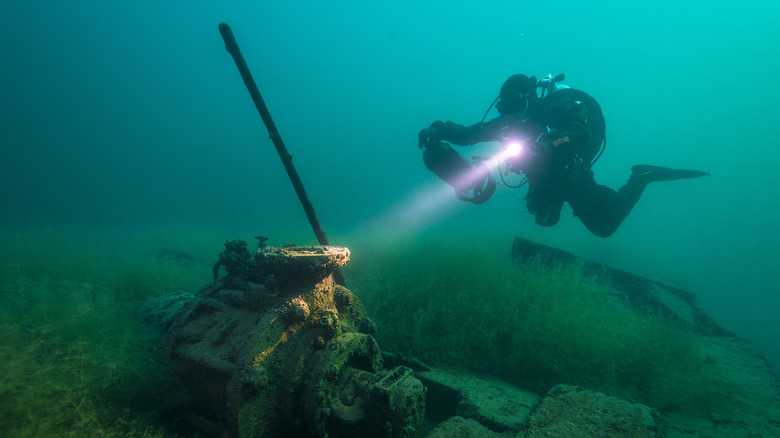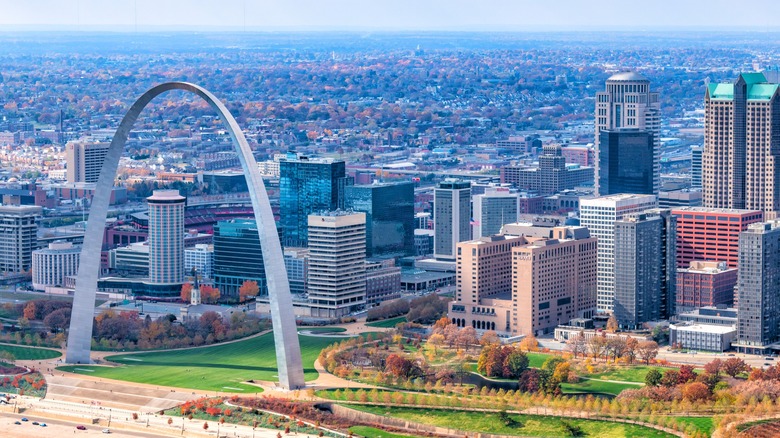The World's Largest Subterranean Lake Is A Vibrant Scuba Diving Paradise In Missouri
Hidden below the surface of a small, southeast Missourian town is a strange and unexpected find: An abandoned mine, which has become a year-round scuba diving haven. Attracting around 15,000 divers and double that number of tourists, Bonne Terre Mine is a National Historic Site and home to the Billion Gallon Lake.
The town of Bonne Terre has a population of just under 7,000 and its name translates to "good earth" in French. It is nestled in the Ozarks, a scenic mountain region that has become a tourist hotspot due to its unparalleled natural beauty. Native Americans living here first discovered galena, a natural mineral and the most important ore in lead. Later, the area was colonized by French settlers, who wanted to benefit from this aptly-named resource-rich land, so they built a lead-mining operation in 1860. Dug out entirely with hand tools, this mine goes down five stories and covers roughly 457,000 square feet. It attracted laborers from many parts of the world, particularly Hungary and southern Europe. The galena from here was used primarily for the lead in ammunition, especially during the Industrial Revolution and the Spanish-American War. The mine was active for 100 years, from 1862 until 1963, and in its heyday, it was the biggest and most profitable lead ore mine in the world.
However, all good things must come to an end, and eventually, Bonne Terre Mine ceased its operations. There was almost no lead left to extract, and both the equipment and the method of mining used were now obsolete. The machinery was too heavy and cumbersome to remove, so it was simply left down below. Over time, groundwater seeped into the cavern, flooding the many passageways and creating the world's largest subterranean lake.
What to expect on your dive at Bonne Terre Mine
Nowadays, divers flock from all over the world to visit this midwestern Atlantis. You can dive here throughout the year because the lake retains a constant water temperature of 58 degrees Fahrenheit, even on the snowiest days above ground. Be prepared for your most adventurous history lesson as you take in a well-preserved underwater snapshot of life in the 1800s, passing abandoned mining carts, machinery, scaffolding, and even an elevator shaft. View extraordinary geological formations, including caverns, calcium falls, massive archways, and pillars. You'll swim through crystal-clear, fresh mineral water with nothing disturbing it, so you can expect 100-foot visibility. Although divers aren't permitted to carry dive lights, an extensive overhead lighting system with over 500,000 watts provides ambient illumination for many of the formations. Don't forget your underwater camera for some otherworldly photos (allowed after completing the first dive trail).
There are around 20 dive trails to explore, and all of them require an Open Water Diver certification. The trails must be completed in order, regardless of experience and certification level. Expect that they will get progressively more challenging and interesting. A highlight from one of the advanced dive trails is The City, where you'll see the working level of the mine, with all of its submerged buildings and shops giving off spooky, ghost-town vibes. While the conditions can be similar to cave diving, as certain areas can be pretty dark, a Cave Diver certification is not required, as you'll always have overhead surface access. However, if you have claustrophobia, this may not be the place for you, as some of the passages can be narrow.
Exploring Bonne Terre and the surrounding area
When planning your dives, be aware that they can only be booked on Saturdays and Sundays (as of the time of writing), with some Friday night availability. Groups have a maximum of 14 participants, with a dive guide and safety divers accompanying. If you are traveling with non-divers, there are options for them that don't require a descent into the deep unknown. Boat tours (60 minutes) are available, and guided walking tours (45 minutes) take participants down the Old Mule Trail on a memorable historical journey.
Divers and non-divers alike can reserve a room at the Bonne Terre Depot for a unique stay. Formerly a bustling train station built in 1909 and used mainly by employees of the lead operation; it is now a quiet bed and breakfast just half a mile from the mine, where you can sleep in a restored 20th-century train car. Dive and lodging packages can also be arranged by Bonne Terre Mine at the depot or other nearby guesthouses.
If you're planning to explore the surrounding area, the lively city of St. Louis is an hour away. Take in a Cardinals game, ride to the top of the Gateway Arch, and visit one of the best-rated zoos in the Midwest in beautiful Forest Park. Missouri's wine country should be on your list as well, with a stop in Hermann, about two hours northwest of the mine. Enjoy this charming and underrated Missouri town and explore its wine trail for yourself.


